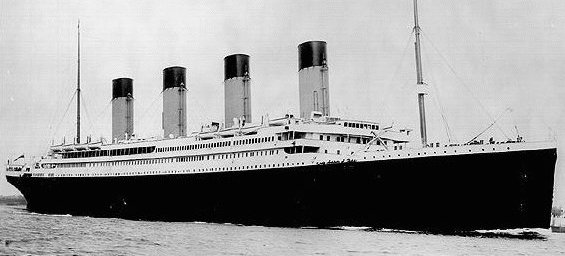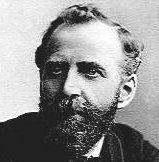
In 1898 (14 years prior to the Titanic tragedy), Morgan Robertson wrote a novel called Futility. This fictitious novel was about the largest ship ever built hitting an iceberg in the Atlantic ocean on a cold April night. The fictional ship (named Titan) and the real ship Titanic were similar in design and their circumstances were remarkably alike. Both ships were labeled "unsinkable".
- RMS stands for Royal Mail Steamer. RMS, in formal terms, means "Royal Merchant Ship". However, the dual meaning was also "Royal Mail Steamer", because the Titanic carried mail under the auspices of His Majesty's postal authorities. At that time, all ships, military and civilian, that were under the British flag carried the distinction of "R.M.S." This, in effect, gave the ship the protection of the British Crown. An attack on an R.M.S. was considered an attack on the crown and an act of war.
- Two dogs were among the Titanic survivors.
- There were no cats on the Titanic. Cats were often brought on ships as a form of good luck. They also controlled rodents.
- The Titanic is about as long as the Empire State building is tall.
- The Tower Bridge, located in London England, is approximately the same length and height as the Titanic.
- Originally, the Titanic's design only included 3 funnels (smokestacks). The aftmost funnel (towards stern) was added to make the Titanic look more impressive-it gave the feeling of "power and grace". It only functioned as an air vent.

No one ever claimed that the Titanic was "unsinkable". The quote, "practically unsinkable" was taken out of context. In 1911, Shipbuilder magazine published an article describing the construction of the Titanic. The article stated that when the watertight doors were closed, the ship would be "practically unsinkable".
- It was customary to break a bottle of champagne on the bow of a boat when launched. The Titanic launching did not include the traditional bottle-breaking.
- Many of the passengers were not originally suppose to be traveling on the Titanic. Due to a strike, coal was in short supply. This shortage threatened Titanic's maiden voyage and forced the White Star Line to cancel travel on the Oceanic and Adriatic and transfer their passengers and coal stocks to the Titanic.
- There were 13 couples on board celebrating their Honeymoons.
- Captain Smith was planning to retire after Titanic's maiden voyage.
- The Titanic had 4 elevators (3 in First class and 1 in Second class).
- At the time, Titanic's whistles were the largest ever made.
- Titanic's whistles could be heard from a distance of 11 miles.
- The Titanic carried 900 tons of baggage and freight.
- The Titanic used 14,000 gallons of drinking water every 24 hours.
- Coal consumption per day: 825 tons.
- Carried 20 lifeboats and 3560 life jackets. The life jackets were made of canvas and cork.
- More than 3 million rivets were used to build the Titanic.
- In a test done to determine stopping distance, the Titanic was accelerated to 20 knots and then the engines were reversed at full power. The distance required to stop the Titanic was about half a mile.
- The Titanic's radio call sign was: MGY.
- Port of Registry - Liverpool, England. Registry date: March 24, 1912.
- Official ship number: 131,428
- The number 3909 04 was NOT assigned to the Titanic as a hull number.

The lookouts in the crow's nest did not have binoculars. Having binoculars might have prevented the Titanic tragedy.
- The time interval from first sighting of the iceberg to impact was a little over 30 seconds.
- The Titanic sank 2 hours and 40 minutes after hitting the iceberg.
- It probably took Titanic about 15 minutes to sink to her final resting place on the ocean floor. That means that Titanic sank at a rate of 10 miles per hour (or 16 km per hour).
- The Titanic hit the iceberg on the starboard (right) side of the bow. It has been speculated that the Titanic may have suffered only minor damage and minimal loss of life had it hit the iceberg head-on. It has also been suggested that the Titanic may have completely avoided colliding with the iceberg had the bridge not requested that the engines be reversed ("Full Astern"), prior to steering the ship to the left ("Hard-a-starboard"). This action would have decreased the forward momentum of the Titanic causing it to turn at a slower rate.
- July and August are the only two months the weather permits expeditions to the Titanic wreck site.
Strange, but True:
British spiritualist, William T. Stead, wrote a tale similar to Futility (mentioned at the top of the page). "How the Mail Steamer went down in the Mid Atlantic, by a survivor" appeared in the March, 1886 issue of Pall Mall Gazette. In this story, Stead tells of a large steamship that sinks after colliding with another ship. Many lives are lost due to lack of lifeboats. Stead wrote that, "This is exactly what might take place and what will take place, if the liners are sent to sea short of boats". Stead was travelling to the United States at the request of President Taft to address a peace conference at Carnegie Hall on April 20, 1912. Stead sat calmly in the library reading a book as the North Atlantic sea water came rushing in as the ship he was traveling on sank. That ship was the Titanic. Stead did not survive.
appeared in the March, 1886 issue of Pall Mall Gazette. In this story, Stead tells of a large steamship that sinks after colliding with another ship. Many lives are lost due to lack of lifeboats. Stead wrote that, "This is exactly what might take place and what will take place, if the liners are sent to sea short of boats". Stead was travelling to the United States at the request of President Taft to address a peace conference at Carnegie Hall on April 20, 1912. Stead sat calmly in the library reading a book as the North Atlantic sea water came rushing in as the ship he was traveling on sank. That ship was the Titanic. Stead did not survive.
William T. Stead also authored the novel From the Old World to the New. In this book, he describes the sinking of a ship in the North Atlantic after striking an iceberg. To add to the irony, the captain of the ship which picked up the survivors, was Edward J. Smith -- the eventual captain of Titanic.
go to the website to continue reading!
No comments:
Post a Comment